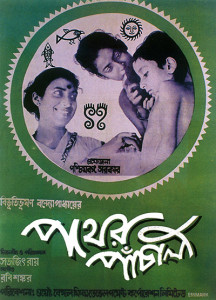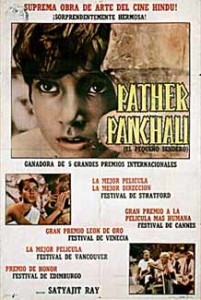If memory serves, Pather Panchali is the first Indian film that I have had the pleasure of watching. I have noticed, through this project, that film as art does not always struggle from provincial stereotyping. Cinema from India is widely recognized for Bollywood films that seems to be extruded through a mold that has a few minor differences, like a Michael Bay film, and this is something that Satyajit Ray wanted to avoid when making Pather Panchali.
The film, part one in the Apu Trilogy, introduces the audience to Apu in his young childhood, giving viewers insight into the life of a poor family in India. Along with Apu, we meet his parents, Harihar and Sarbajaya, his sister Durga, and his aunt Indir. In the same vein of European art house cinema it gives us a slice-of-life story that does have twists and crises and climaxes, but they are much slighter and easy to miss.
Something that I find very interesting in this project is that I am offered a chance to have a global travelogue, a chance to see different places around the world, but it is also a time machine. Before watching the film I did not have a clear reference of what to expect out of rural India, but much of the landscape of Pather Panchali was reminiscent of rural Appalachia. I often struggle with seeing similarity when looking at a distance, or sometimes not looking at all. This sounds foolish, I know that, but I also forget – or don’t consider – how small this planet has really become.
Pather Panchali is a very well-made picture and Satyajit Ray captured the innocence of Apu and Durga before they knew anything about class structure or culture. Just children experiencing life while the parents hoisted the burdens of life high enough for their children to pass under, mostly unscathed. The plot is difficult to discuss without ruining anything for the viewer; as I mentioned, the breadth of the story is slight, but that does not mean that it is not dense.
I wish that I had watched this, along with with Bicycle Thieves and The 400 Blows, when I was younger to really be able to wring out all of the lessons. That is not to say that these are children’s movies; rather, they probably exist on two completely separate levels, giving young viewers a completely different moral than it does an older viewer.
Trailer
https://www.youtube.com/watch?v=33mF_xT5QXQ
Important Links

